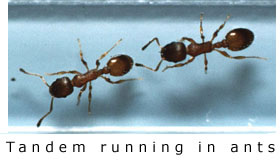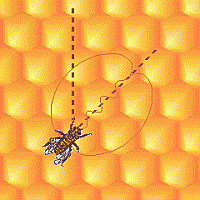Tactile Communication
“Keep in touch!” For you, it’s probably just a metaphor, but for some insects it’s really a channel of communication. Since many insects have poor vision and sound perception, physical contact provides an important avenue of communication. In blister beetles (family Meloidae), courtship begins with a series of antennal taps by the male on each side of the female’s body. She signals her receptivity by lifting her wing covers (elytra) and allowing him to climb on her back. But to complete his quest, the male must continue tapping, alternating from side to side at just the right frequency until the female is stimulated to extend her genitalia and begin mating.
 Antennal tapping is also an essential component of communication in both ants and termites. It’s not clear exactly what information may be exchanged, but it certainly involves nestmate recognition and leads to exchange of food through trophallaxis. In some cases, instantaneous feedback allows the sender to monitor the receiver’s response and alter the signal if necessary. Antennal tapping on the hind legs is used during tandem running in both ants and termites. This is a “follow-the-leader” behavior in which the tapping informs the leader that she has not lost her disciple. If tapping stops, the leader instinctively turns around and searches in ever-widening circles until she re-establishes contact with the follower.
Antennal tapping is also an essential component of communication in both ants and termites. It’s not clear exactly what information may be exchanged, but it certainly involves nestmate recognition and leads to exchange of food through trophallaxis. In some cases, instantaneous feedback allows the sender to monitor the receiver’s response and alter the signal if necessary. Antennal tapping on the hind legs is used during tandem running in both ants and termites. This is a “follow-the-leader” behavior in which the tapping informs the leader that she has not lost her disciple. If tapping stops, the leader instinctively turns around and searches in ever-widening circles until she re-establishes contact with the follower.
 The “dance” language of honeybees is largely a tactile communication system, performed in total darkness on the vertical surface of the honeycomb. A “round dance” signals to nestmates the presence of a nectar source in close proximity to the hive (usually less than 80 feet). It consists of a series of circular runs with more or less frequent changes in direction. The greater the frequency of direction changes, the better the quality of the nectar source. The “waggle dance” is used for longer distances. It involves a figure eight pattern with a series of abdominal waggles on a straight run after each half-circle turn (see figure at left). More about
The “dance” language of honeybees is largely a tactile communication system, performed in total darkness on the vertical surface of the honeycomb. A “round dance” signals to nestmates the presence of a nectar source in close proximity to the hive (usually less than 80 feet). It consists of a series of circular runs with more or less frequent changes in direction. The greater the frequency of direction changes, the better the quality of the nectar source. The “waggle dance” is used for longer distances. It involves a figure eight pattern with a series of abdominal waggles on a straight run after each half-circle turn (see figure at left). More about
Dance Language Distance is indicated by the duration of the straight run and the frequency of the waggles. Direction is indicated by the angle of the straight run (relative to vertical) and corresponds to the horizontal angle between the sun and the direction of the food source.
Tactile cues generated by ripples on the water surface allow whirligig beetles (family Gyrinidae) to constantly monitor the location of dozens of other nearby whirligigs. Thanks to this tactile communication system, the whirligigs can swim rapidly in circles, avoid bumping into other members of their own species, and still detect the presence of nearby predators or prey.

 Certain treehoppers (order Hemiptera: family Membracidae) produce vibrations in the tissue of their host plant that can be felt by all other treehoppers on the same plant. The signal travels throughout the plant in much the same way that banging on water pipes in your apartment creates noise throughout the whole building. The signals apparently work as an alarm system, and in some species, they may be used by nymphs to elicit protective maternal behavior. Substrate vibrations can be a particularly effective system of communication for small insects who cannot generate an acoustic signal loud enough to be heard more than few inches away.
Certain treehoppers (order Hemiptera: family Membracidae) produce vibrations in the tissue of their host plant that can be felt by all other treehoppers on the same plant. The signal travels throughout the plant in much the same way that banging on water pipes in your apartment creates noise throughout the whole building. The signals apparently work as an alarm system, and in some species, they may be used by nymphs to elicit protective maternal behavior. Substrate vibrations can be a particularly effective system of communication for small insects who cannot generate an acoustic signal loud enough to be heard more than few inches away.